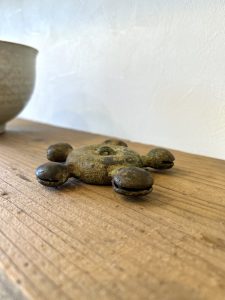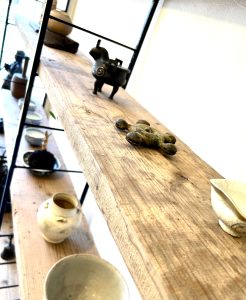長い年月をまとう風格(愛知県名古屋市千種区姫池通骨董 骨董買取 古美術風光舎)
2023.10.22
皆さまこんにちは。スタッフHでございます。
秋と言えば金木犀の香りや紅葉、焼き芋に栗ご飯。数えればきりがありませんが、私の秋の楽しみの一つは隣の中学校から聞こえてくる校内合唱コンクールの練習の歌声です。本番直前ともなるとクラスごとの朝練も始まります。思春期真っ只中の男子生徒が元気に張り上げる声、女子生徒の透き通った美しいコーラス。気分が晴れ晴れします。
さて本日は、歴史を感じる風格と貫禄をもつ道具たちをご紹介します。大切に扱ってきた人々のリレーにより現代まで受け継がれてきました。

この中で一番古いと思われる手前の円盤のような道具。店内で異彩を放っており触るのも憚られましたが、お掃除の時にそーっと持ち上げてみると、なんとも軽くて心地のよい音がしました。コロコロ?カラカラ?シャラシャラ?…文字では表現できないので、ご興味のある方は是非お店の方に聞きにいらしてください。
こちらは「鈴鏡(れいきょう)」と呼ばれ、古墳時代後期(5世紀~6世紀)に製造・使用された銅鏡の一種で、鈴によって音を発する鏡です。青銅鏡の周辺部に鈴が付けられ、三鈴から十鈴までのうち九鈴を除いた七種類が現在までに発見されているとのこと。こちらは鈴が5つ付いているので「五鈴鏡」です。出土は日本の古墳に限られ、他の地域からの出土は見られないそうです。
鏡も鈴も大陸や朝鮮半島からもたらされたものですが、それらを当時の日本人が一体化させたと考えられています。

鏡がなかった時代、自分の姿を見ることができない感覚とはどんなものだったのでしょうか。自分の姿を見たいという欲求はいつの時代にもあったはずです。教科書に載っていた「三角縁神獣鏡」を見て、本当に姿見の役目を果たしたのかと疑問でしたが、少しの歪みはあるものの、かなり鮮明に映ったようです。庶民は水面に映る姿が限界だったかもしれませんね。
いにしえの日本では、鏡は姿見というよりは特権階級の権力を誇示し、信仰的、呪術的な意義の方に重きを置いていたと考えられます。当時の豪族が宝物として保持し埋葬の際に棺の中に入れて魂が失せるのを防いだともいわれています。
また鈴には古来より「邪悪なものを祓う力」があると考えられてきました。神社の拝殿入口に吊るしてある大鈴(坪鈴)は「神様、お願い事を聞いてくださいねー」と鳴らすのではなく、「鈴の音」で邪気をお祓いするために鳴らすそうです。私は完全に「お参りに来ましたよー」という心持ちでおりました…。
もう一つ、鈴の音には「心を引きつける」力もあると考えられました。奉納舞などで巫女が手に持ち鳴らす鈴はこちらの意味を持ち、澄んだ鈴の音で神様の御霊を引き付ける役目を果たしていたようです。
信仰的、呪術的な力を強めるためなのか、鏡の周りに鈴を付けよう!と思い立った当時の人々。日本人らしい気質やセンスを感じてしまうのは私だけでしょうか。
埴輪の巫女には「五鈴鏡」を腰に付けたものがあるとか。風光舎にある五鈴鏡にも紐をつけるような部分がありますね。古の時代には祭事などで人々を高揚させ、神様を引きつける役割を果たしていたのでしょうか?
五鈴鏡の話が長くなってしまいました。他のお道具はまた次の機会に。

それでは、またお会いしましょう。
Hello everyone. This is Staff H.
Autumn is the season of fragrant fragrance of fragrant rhinoceros, autumn leaves, roasted sweet potatoes, and rice with chestnuts. There is no end to the number of things to do, but one of my favorite things about autumn is the sound of singing from the neighboring junior high school as they practice for the school choir competition. Just before the competition, morning practice for each class begins. Boys in the midst of puberty sing energetically, and girls sing beautiful, clear choruses. It makes me feel refreshed.
Today, I would like to introduce some tools that have a stature and dignity with a sense of history. They have been handed down to the present day through the relay of people who have taken good care of them.
The disk-like tool in the foreground is probably the oldest of all. I was afraid to touch it, but when I lifted it gently while cleaning, it made a light and pleasant sound. Rolling? Rattle? Rattle? …It is hard to describe in words, so if you are interested, please come to the store and ask us about it.
This is a “bell mirror,” a type of bronze mirror manufactured and used in the late Kofun period (5th to 6th century), which emits sound with a bell. Bells were attached to the periphery of bronze mirrors, and seven types have been discovered to date, excluding nine bells, out of a range of three to ten bells. This one is a “five-bell mirror” because it has five bells. The excavation of these mirrors has been limited to ancient tombs in Japan, and they have not been found in other regions.
Both mirrors and bells were brought from the continent and the Korean peninsula, and it is believed that the Japanese of that time combined them into a single piece.
What was it like to feel unable to see one’s own image in an age when there were no mirrors? The desire to see oneself must have existed in any age. When I saw the “triangular-rimmed mirror” in a textbook, I wondered if it really served as a mirror, but it seems to have reflected the image quite clearly, albeit with a slight distortion. The common people may have been limited to the reflection on the surface of the water.
In ancient Japan, mirrors were more likely to be used to show off the power of the privileged class and to have religious or magical significance than to serve as a mirror. It is said that the powerful families of the time kept mirrors as treasures and placed them in coffins during burials to prevent the loss of their souls.
Bells have also been believed to have the power to exorcise evil since ancient times. The large bell (tsubo-ring) hung at the entrance to the shrine is said to be rung not to say, “God, please listen to my request,” but to purify evil spirits with the sound of the bell. I was completely in the mindset of “I came to visit the shrine….
The sound of the bell was also thought to have the power to “attract people’s hearts. The bells that miko (shrine maidens) hold in their hands and ring during dedication dances have this meaning, and the clear sound of the bells seems to have served the purpose of attracting the spirits of the gods.
People at that time thought of putting bells around mirrors to strengthen their religious and magical power! The people of that time came up with the idea of putting bells around mirrors, perhaps to strengthen their religious or magical power. Am I the only one who feels the Japanese temperament and sense?
I heard that some haniwa maidens had “five bell mirrors” attached to their waists. The Isuzu mirror in the Fukosha also has a part that looks like a string attached to it. Did it play a role in uplifting people and attracting gods at festivals and other events in ancient times?
It has been a long story about the Isuzu mirror. I will leave the other props for the next time.
Well, I will see you again.
*******************
ご実家の整理やお片付けなどをされている方のご相談などが多くございます。
お片付けなどくれぐれもご無理のないようになさってくださいませ。
風光舎では古美術品や骨董品の他にも絵画や宝石、趣味のお品など様々なジャンルのものを買受しております。
お片付けをされていて、こういうものでもいいのかしらと迷われているものでも、どうぞお気軽にご相談下さいませ。
また風光舎は、出張買取も強化しております。ご近所はもちろん、愛知県内、岐阜県、三重県その他の県へも出張いたします。
まずは、お電話お待ちしております。
愛知県名古屋市千種区姫池通
骨董 買取【古美術 風光舎 名古屋店】
TEL052(734)8444
10:00-17:00 OPEN
#出張買取#骨董#古美術#骨董品#絵画#版画#茶道具#刀剣#彫刻

